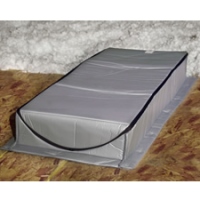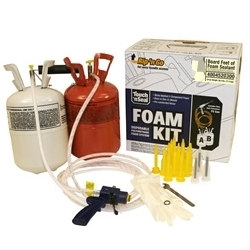
Creaky, drafty attics certainly have a place in the world of horror flicks, but that draftiness does nothing for the homeowner. Three often overlooked sources of poor attic insulation are the stairs, knee wall doors, and the scuttle hole access. Using a stairway cover is one way to shield all three of those areas from causing inconsistent temperatures in the attic and a bigger (much scarier) problem on your energy bill.
Attic Stairs
It may seem insignificant, but that large hole in the ceiling does nothing to stop air leaks. Attics stairs usually take up 10 sq.ft. of the ceiling, leaving a huge gap around the opening for air to swim on through. Installing a stairway cover requires a little bit of work but yields obvious results.
Knee Wall Doors
When building an attic under a sloped roof, that sloping creates an oddly shaped space underneath it. The shape is like folding a piece of paper in half, laying it flat, then lifting the top halfway up – simply put, a sideways triangle. A knee wall is basically a short wall that creates a room out of that space. To get in and out of that area (naturally), you need a knee wall door. Sometimes a knee wall door can lead to a space that is outside the home (usually the area is there to ventilate the roof), giving opportunity to air, critters, and who knows what else to make its way into your home. Properly sealing knee wall doors should definitely be a high priority on your insulation list.
Scuttle Hole Access
The attic scuttle hole is small, usually 2′ x 2′ entrance way to the attic. If a home doesn’t have stairs that lead to the attic, then the only way to get into it is through a scuttle hole. Just like with attic stairs, the area around the scuttle hole is where the damage occurs. A stairway cover or attic cover will work just as well on attics that only have the scuttle hole access; you’ll just need less material.
Now the attic can still be a scary place but insulating it doesn’t have to be. To minimize stress with this DIY project, use the right tools, wear protective gear if needed, and read the instructions before working with insulation products.









